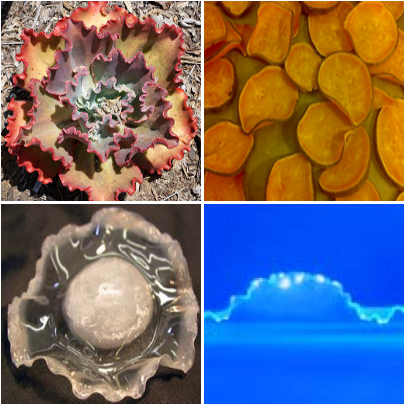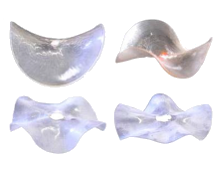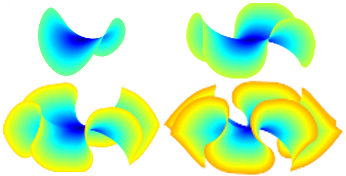
Mathematical Model:
For metrics with non-zero Gaussian curvature the bending and stretching terms cannot both vanish globally and the competition between these two energies sets the equilibrium configuration. Specifically, in the vanishing thickness limit the stretching energy is dominant and minimizers converge to a shape that minimizes the bending energy over all possible isometric immersions. This type of specified morphogenesis is being explored as a technique for creating desired three dimensional structures. The advantage of this technique over direct casting is that the process is reversible and can be used to create "soft machines" such as actuators, valves, and pumps. The mathematics I am working on will allow these structures to be realized by accurately predicting equilibrium shapes from swelling data.
Work to Date:
My work to date has focused on studying thin elastic disks with a metric \(\mathbf{g}\) that has corresponding constant negative Gaussian curvature \(K_0\). In this geometry, stretching-free configurations correspond to local isometric immersions of the hyperbolic plane \(\mathbb{H}^2\), which exist for arbitrarily large domains. Experimentally such sheets obtain a periodic profile with a refinement of the number of waves with decreasing thickness (see the leftmost figure below). This seemingly indicates that the shapes are not converging to an isometric immersion which is in contradiction with the variational model.


In [5] we showed by direct construction that there exist local isometric immersions of \(\mathbb{H}^2\) with periodic profiles that for the range of radii used in experiments qualitatively resemble the hydrogel shapes (see the rightmost figure above). For purely geometrical reasons, the number of waves in these isometric immersions refine with increasing radius matching observations in crochet models of \(\mathbb{H}^2\). Moreover, we provided strong numerical evidence that for large radii these periodic shapes are energetically preferred over saddle shapes. However, in [4] we rigorously proved by finding ansatz free scaling laws that for the range of parameters used in experiments the global minimizers of the variational problem are saddle shapes for all thickness values. In [1] we show that the self-similar shapes observed in torn plastic can be explained by low energy piecewise smooth isometric immersions.
More information on my work in this area can be found in the publications listed below.
Video of a presentation given at the IMA
Publications Related to this Work:
- Gemmer, J. A., Venkataramani, S. C., Sharon, E. (2015) Isometric immersions and self-similar buckling in Non-Euclidean elastic sheets. (preprint).
- Gemmer, J. A., & Venkataramani, S. C. (2013). Shape transitions in hyperbolic non-Euclidean plates. Soft Matter, 9(34), 8151-8161
- Gemmer, J. A., & Venkataramani, S. C. (2012). Defects and boundary layers in non-Euclidean plates. Nonlinearity, 25(12), 3553.
- Gemmer, J. (2012). Shape Selection in the non-Euclidean Model of Elasticity (Doctoral dissertation, The University Of Arizona).
- Gemmer, J. A., & Venkataramani, S. C. (2011). Shape selection in non-Euclidean plates. Physica D: Nonlinear Phenomena, 240(19), 1536-1552.
Potential Graduate Student Research:
So far my work has focused on studying swelling thin elastic sheets
with a specific swelling pattern, namely one whose geometry corresponds
to constant negative Gaussian curvature. I believe that the results I
have in the case of constant Gaussian curvature will still hold for
more generic swelling patterns. One
way a student could assist me is by designing, running,
and analyzing numerical simulations of swelling thin elastic sheets
with generic radially symmetric swelling patterns. This
project
could be undertaken by a student with experience in differential
equations, numerical analysis, and programming in a higher level
language like Mathematica
of Matlab. The essential question the student will be exploring is the
role of geometry in determining complex morphologies observed in leaves
and torn plastic. I believe that this project could nucleate into
further research that would have a high impact on the field.
Another project that could be pursued by a graduate student is to develop and analyze a mathematical of swelling thin elastic sheets that incorporates dynamic and stochastic effects. My past work has shown that local but not global minimum seem to be what is observed in practice. This
project
could be undertaken by a student with experience in differential
equations, numerical analysis, elasticity, calculus of variations and programming in a higher level
language like Mathematica
of Matlab. This research could serve as the beginning of a Ph.D. dissertation.